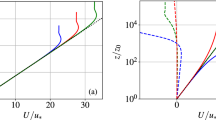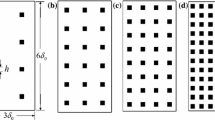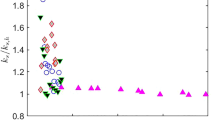Abstract
Flux-profile relationships based on surface-layer similarity theory are used to derive relationships between the Monin-Obukhov stability parameter ξ = z/L and the bulk Richardson number Ri b . In contrast to previous studies, the roughness length for heat, z 0h ,is assumed unequal to the roughness length for momentum, z 0m .For the stable case, an analytic expression of ζ in terms of Ri b can be derived and in the unstable case, the solution is obtained through a simple iterative process.
Errors introduced from the simplification of z 0h = z 0m are evaluated and are shown to be very significant in most cases. Thus, this error in many practical applications may invalidate the intended solution.
Similar content being viewed by others
References
Businger, J. A., Wyngaard, J. C., Izumi, Y., and Badgley, E. F.: 1971, ‘Flux Profile Relationships in the Atmospheric Surface Layer’, J. Atmos. Sci. 28, 181–189.
Brutsaert, W.: 1982, Evaporation into the Atmosphere, D. Reidel Publishing Co., Holland, 299 pp.
Byun, D. W.: 1990, ‘On the Analytical Solutions of Flux-Profile Relationships for the Atmospheric Surface Layer’, J. Appl. Meteorol. 29, 652–657.
Charnock, H.: 1955, ‘Wind Stress on the Water Surface’, Quart. J. Roy. Meteorol. Soc. 81, 639–640.
Daggupaty, S. M., Tangirala, R. S., and Sahota, H.: 1994, ‘BLFMESO-A 3-Dimensional Mesoscale Meteorological Model for Microcomputers’, Boundary-Layer Meteorol. 71, 81–107.
Dyer, A. J.: 1974, ‘A Review of Flux-Profile Relationships’, Boundary-Layer Meteorol. 7, 363–372.
Dyer, A. J. and Bradley, E. F.: 1982, ‘An Alternative Analysis of Flux-Gradient Relationships at the 1976 ITCE’, Boundary-Layer Meteorol. 22, 3–19.
Donelan, M.: 1990, ‘Air-Sea Interaction’, reprinted from The Sea; pp. 239–292, in B. le Mehaute and D. M. Hanes (eds.), The Sea: Ocean Engineering Science, Vol. 9B, Wiley-Interscience, New York.
Garratt, J. R.: 1992, The Atmospheric Boundary Layer, Cambridge University Press, 316 pp.
Geernaert, G. and Larsen, S.: 1993, ‘On the Role of Humidity in Estimating Marine Surface Layer Stratification and Scatterometer Cross Section’, J. Geophys. Res. 98, 927–932.
Hignett, P.: 1994, ‘Roughness Lengths for Temperature and Momentum over Heterogeneous Terrain’, Boundary-Layer Meteorol. 68, 225–236.
Hogstrom, U.: 1988, ‘Non-Dimensional Wind and Temperature Profiles in the Atmospheric Surface Layer: A Re-Evaluation’, Boundary-Layer Meteorol. 42, 55–78.
Kader, B. A. and Yaglom, A. M.: 1970, ‘Heat and Mass Transfer Loss for Fully Turbulent Wall Flows’, Int. J. Heat and Mass Transfer 15, 2329–2353.
Lo, A. K.: 1996, ‘Deposition Velocities of Reactive Gases Across an Air- Water Interface’, Atmospheric Environment, 30, 2329–2334.
Lo, A. K.: 1995, ‘Determination of Zero-Plane Displacement and Roughness Length of a Forest Canopy Using Profiles of Limited Height’, Boundary-Layer Meteorol. 75, 381–402.
Lo, A. K. and McBean, G. A.: 1978, ‘On the Relative Errors in Methods of Flux Calculations’, J. Appl. Meteorol. 17, 1704–1711.
Louis, J.: 1979, ‘A Parametric Model of Vertical Eddy Fluxes in the Atmosphere’, Boundary-Layer Meteorol. 17, 187–202.
Miller, M. J., Beljaars, A. C. M., and Palmer, T. N.: 1992, ‘The Sensitivity of the ECMWF Model to the Parameterization of Evaporation from the Tropical Ocean’, J. Climate 5, 418–434.
Oncley, S. P. and Dudhia, J.: 1995, ‘Evaluation of Surface Fluxes from MM5 Using Observations’, Mon. Wea. Rev. 123, 3344–3357.
Oncley, S. P., Fratchy, C. A., Large, J. C., Businger, J. A., Itsweire, E. C., and Chang, S. S.: 1996, ‘Surface-Layer Fluxes, Profiles, and Turbulence Measurements over Uniform Terrain under Near-Neutral Conditions’, J. Atmos. Sci. 53, 1029–1044.
Smith, S. D.: 1980, ‘Wind Stress and Heat Flux over the Ocean in Gale Force Winds’, J. Phys. Oceanogr. 10, 709–726.
Smith, S. D., Anderson, R. J., Oost, W. A., Kraan, C., Maat, Nico, DeCosmo, J., Katsares, K. B., Davidson, K. L., Bumke, K., Hasse, L., and Chadwish, H. M.: 1992, ‘Sea Surface Wind Stress and Drag Coefficients: The HEXOS Results’, Boundary-Layer Meteorol. 60, 109–142.
Toba, Y. and Ebuchi, N.: 1991, ‘Sea-Surface Roughness Length Fluctuating in Concert with Wind and Waves’, J. Oceanogr. Soc. Japan 47, 63–79.
Wieringa, J.: 1980, ‘A Revaluation of the Kansas Mast Influence on Measurements of Stress and Cup Anemometer Overspeeding’, Boundary-Layer Meteorol. 18, 411–430.
Zilitinkevich, S. S. and Chalikov, D. V.: 1968, ‘Determining the Universal Wind-Velocity and Temperature Profiles in the Atmospheric Boundary Layer’, Izv. Atmospheric Oceanic Physics 4,294–302 (English version: pp. 165–170).
Author information
Authors and Affiliations
Rights and permissions
About this article
Cite this article
Kou-Fang Lo, A. On the role of roughness lengths in flux parameterizations of boundary-layer models. Boundary-Layer Meteorol 80, 403–413 (1996). https://doi.org/10.1007/BF00119425
Accepted:
Issue Date:
DOI: https://doi.org/10.1007/BF00119425




